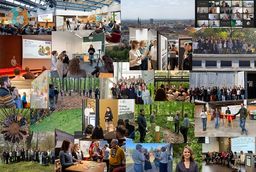1.5 – one scientist, five questions with Prof. Dr. Andreas Schuldt
- April 22, 2025
- 7 min. Reading time

Hello Prof. Dr. Schuldt, you are the head of the Department of Forest Nature Conservation at Georg August University Göttingen and conduct research on biodiversity change. What makes this field of research so exciting?
Biodiversity is fundamental to the functioning of ecosystems such as forests, meadows, and water bodies. This makes it ultimately indispensable for our own well-being, as we depend on the functions and services provided by these ecosystems. Without species diversity, the production of food and resources such as wood, as well as water and air purification, are often on shaky ground. Scientific studies over the last two decades have proven this. Current developments, such as the recent large-scale damage caused by drought and bark beetles, especially in monocultures of tree species that are often unsuited to their location, such as spruce, also demonstrate this. Against the backdrop of climate change in particular, the question arises as to how ecosystems can remain productive and stable for us at the same time. Promoting biodiversity can be an important part of the solution here. Promotion is also important because our influence on nature and the landscape through increasingly intensive use and higher resource consumption is simultaneously leading to the impoverishment of many habitats. Well-known examples include declines in pollinators such as bees, the “insect die-off,” and the disappearance of familiar bird species from our living environment. However, we are only slowly beginning to understand the consequences for ecosystems and their “performance.”
Biodiversity is more than just the diversity of bee, tree, or bird species. In Germany alone, for example, there are over 30,000 different insect species. In many cases, we do not yet fully understand their ecological role or find it difficult to quantify because we lack knowledge about these species and how they interact with other species. A better understanding of the role that biodiversity plays in ecosystems, the drivers of positive biodiversity effects, and how we humans can influence them directly or indirectly will help us to secure our livelihoods in a sustainable and future-oriented way. As a scientist, I am also fundamentally fascinated by the fact that understanding the patterns and functioning of biodiversity provides deep insights into the processes and mechanisms that keep ecosystems and “nature” running.
What is your subproject in the Climate Future Lab DIVERSA about?
In the DIVERSA project, our team is investigating how climate change-induced changes in our forests in recent years are affecting the diversity and composition of species communities and the associated ecological functions. Specifically, we are looking at the impact of the increasingly frequent dry summers with prolonged periods of drought in recent years. These summers have led to the death or loss of vitality of trees and thus to changes in forest structure. The consequences of this for the biodiversity of forest organisms is a very active field of research and can help us to better understand the impact of advancing climate change on our forests and to develop practical recommendations for action. In DIVERSA, we also compare forests with and without forestry use in order to include the direct influence of humans.
In our subproject, we focus on the species group of moths, which are representative of a large number of other insect groups. Moths are extremely species-rich, include many specialized species that are sensitive to environmental changes, and play important ecological roles in forests: for example, as food for birds and bats, as pollinators, but sometimes also as forest pests. In addition to the species diversity and species composition of moths, we are also interested in the effects of climate change-induced structural changes in forests on the extent of plant defoliation caused by moth larvae on the one hand and the biological control of potential pests on the other.
What effects does climate change have on biodiversity in Central European forests, and what effects can be expected?
This is an exciting question that is not easy to answer. On the one hand, climate change is expected to lead to a changed and more diverse forest landscape by promoting natural disturbances such as dry summers, storms, and mass reproduction of economic pests. This may favor species that have been less favored in the current forest landscape, such as light-demanding forest species, species of early forest development phases and disturbance areas, and possibly also deadwood colonizers. On the other hand, the effects also depend heavily on how forest management adapts to climate change. It is clear that there will be changes in species composition in the long term, whether through naturally immigrating tree species, the promotion of climate-adapted native tree species, or the targeted planting of new species. Increased cultivation of non-native tree species adapted to climate change is not necessarily beneficial for forest biodiversity, as many herbivorous insect species, for example, are not adapted to such new tree species. Shorter rotation periods, i.e., the time until timber is harvested, due to faster growth can also cause problems, for example, for old-growth forest dwellers, unless suitable replacement measures are taken. However, adapting forest management to climate change also offers opportunities for greater naturalness, for example, by increasing the use of mixtures of different tree species instead of pure coniferous cultures, which are more susceptible to disturbance. It is also important not to consider climate protection goals, for which forests play a major role, without taking nature conservation goals into account.
Your research group focuses on arthropod communities. Why is insect research so important for forest nature conservation?
Insects and other arthropods, such as spiders, make up the majority of the biodiversity of multicellular organisms in forests. This clearly illustrates the fundamental importance of biodiversity conservation for nature conservation. All these species perform important ecological functions, from decomposing dead plants or animals to feeding on living plants and controlling populations as predators or parasitoids [organisms that live parasitically on a host during their development and ultimately kill it]. Without them, the forest cannot function as it should. Even if we often do not perceive their contribution as directly and clearly as that of trees or large animals. Changes in the biodiversity of these species groups can also influence important interactions, for example between potential harmful organisms and their food competitors or antagonists. On a small scale, this can already be observed in garden ponds: without dragonfly larvae and other predators, they become a paradise for mosquito larvae. With their enormous numbers and biomass, arthropods are also a food source for other species groups, such as birds, reptiles, and many mammals. Studies in recent years have shown that declines in arthropod biodiversity and biomass are also being observed in forests. A better understanding of the reasons for this and the ability to take countermeasures should therefore also be a key concern of nature conservation in forests.
How can nature and biodiversity in forests be protected and made climate-resilient?
Nature conservation and biodiversity protection are receiving increasing attention and consideration in forest management. In the past, many sensible measures that can be further expanded have already been integrated into management, ranging from the promotion of resources that are often underrepresented in commercial forests but are vital for many species (in the form of deadwood, old trees, and habitat trees) to forest conversion with natural regeneration and the promotion of deciduous forests, to the designation of forest areas that are not used for commercial purposes and are left to develop naturally. Part of a nature-compatible strategy for the future in times of climate change may be to allow forests to develop more momentum of their own by adapting and diversifying their use objectives. This could involve, for example, developing alternative ways of using wood and taking greater account of the provision of important ecosystem services in relation to the protective and recreational functions of forests, while at the same time making them more economically attractive. In view of the uncertainties in predicting the most suitable management approaches and as a safeguard for the future, this may also involve diversifying management practices, i.e., neither age-class nor permanent forests as a universal solution. This may also include further promotion of forest areas with natural development as refuges for many species and as learning sites for assessing natural adaptation potential. In principle, the fragmentation of forests, i.e., increasing isolation, should be avoided and the biotope network promoted in order to enable species to survive for as long as possible under changing environmental conditions and, at the same time, to allow the use of suitable migration corridors. Future development should be accompanied by targeted, long-term monitoring of biodiversity in order to identify influencing factors and, if necessary, take appropriate countermeasures.
Thank you very much for the interview.
Contact person

More Posts
All
Happy Holidays!
We wish everyone relaxing days, time to take a deep breath and a good start to the new year. We will be available again from 5 January.
1 min. Reading time
2025 Year in Review – The ZKfN Year in Pictures
2025 was marked by the expansion of the Climate Future Labs, new collaborations and a more closely networked climate community in Lower Saxony.
5 min. Reading time
How collaboration across disciplinary boundaries works
The workshop at the ZKfN symposium showed the prerequisites for interdisciplinary and transdisciplinary collaboration and the added value it creates.
3 min. Reading time